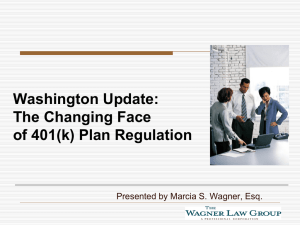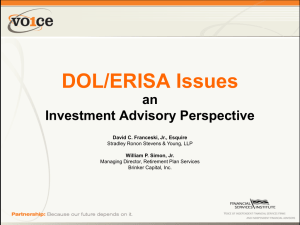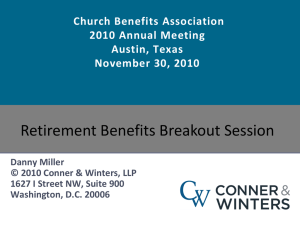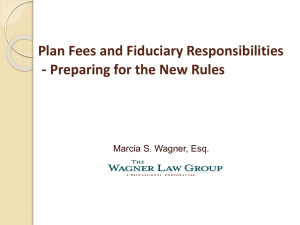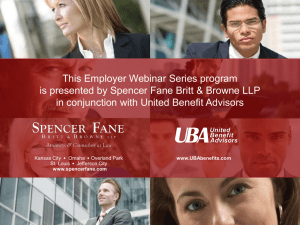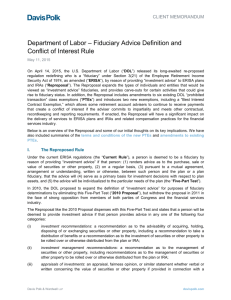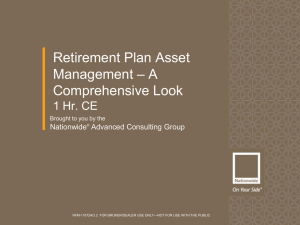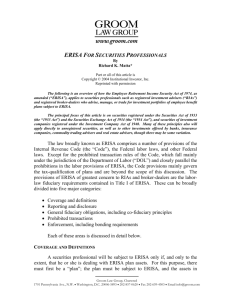Fee Disclosures: Impact on Broker-Dealers
advertisement
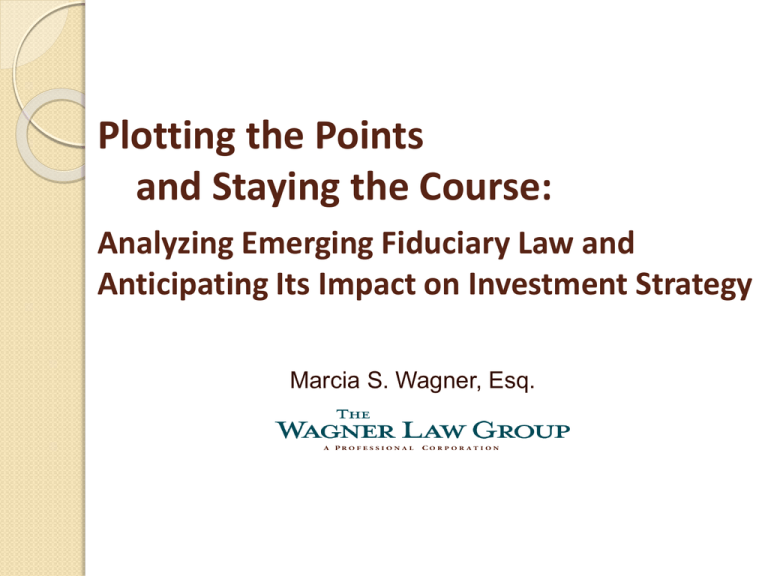
Plotting the Points and Staying the Course: Analyzing Emerging Fiduciary Law and Anticipating Its Impact on Investment Strategy Marcia S. Wagner, Esq. 1. Implications of Accounting Standards 2. Managing Fiduciary Risk 3. Impact of “New” Fiduciary Standards 2 Revised Accounting Standards Original Rules under FAS 87 ◦ ◦ ◦ ◦ Issued in 1985 De-linked cash contributions and pension expense. Introduces expense volatility to Income Statement. Footnote disclosures only for plan’s funded status. Revisions Under FAS 158 ◦ Rule changes issued in 2006. ◦ Plan’s funded status moved from footnote into Balance Sheet. ◦ Introduces funding-based volatility to Balance Sheet. 3 Liability Driven Investments Introduction ◦ LDI strategy designed to reduce expense and liability volatility. ◦ Matches asset allocations with benefit liabilities. Immunization Using Plan’s Bond Portfolio ◦ Bond portfolio constructed to match plan’s future stream of benefit payments. ◦ Benefit liabilities may be segmented by duration. ◦ For example, portfolio may immunize shortand intermediate-term liabilities only. 4 Other Aspects of LDI Strategies Hedging Interest Rates ◦ Non-immunized benefit liabilities increase if rates fall. ◦ May hedge through interest rate derivatives. Reduction in Plan’s Expected Rate of Return ◦ Shifting allocations from equity to bonds will lower plan’s expected return. ◦ Lower expected return may increase pension expense and cash contributions. ◦ One-time cash contribution may be required to avoid such increases. 5 ERISA Implications for LDI Duty of Loyalty ◦ Fiduciaries must act for exclusive purposes of providing benefits and defraying reasonable costs. ◦ But is LDI strategy for employer or plan participants? Conflict-of-Interest Rules ◦ ERISA prohibits fiduciary self-dealing. Duty of Prudence ◦ Traditional strategies emphasize maximizing return for given level of risk. ◦ LDI strategies emphasize minimizing volatility. 6 DOL Guidance on LDI Strategies Advisory Opinion 2006-08A ◦ Investment manager requests DOL’s opinion on whether LDI strategy violates ERISA. ◦ Argues that lower volatility also reduces underfunding risks. ◦ Notes incidental benefit to employer for financial reporting purposes. 7 Advisory Opinion 2006-08A (cont’d) Favorable opinion issued to investment manager. ◦ Plan fiduciaries have broad discretion. ◦ No restrictions against fiduciary’s consideration of liabilities. Adv. Opinion does not address issues under Duty of Loyalty and Conflict-of-Interest Rules. ◦ But courts have ruled that incidental benefit for employer is ok. ◦ DOL made similar ruling in Adv. Opinion 2001-01A. 8 LDI-Related Best Practices Emphasize benefit to plan participants. ◦ Meeting minutes should highlight benefits from plan’s perspective. ◦ Employer’s benefits from LDI strategy should be incidental only. Financial officers should recuse themselves from any fiduciary vote on LDI strategy. ◦ Perception issue, especially if LDI proposal significantly reduces plan’s expected return. ◦ Financial officer may approve LDI proposal on behalf of employer (and not on behalf of plan). 9 LDI-Related Best Practices (cont’d) Hire outside experts. ◦ Engage an independent co-fiduciary when implementing and monitoring LDI strategy. Revise investment policy statement (IPS). ◦ Plan fiduciaries are subject to guidelines in IPS. ◦ Must revise to avoid violations of IPS. Update plan and trust documents. ◦ Amend to reflect any additional named fiduciaries, and to accommodate use of financial derivatives. 10 1. Implications of Accounting Standards 2. Managing Fiduciary Risk 3. Impact of “New” Fiduciary Standards 11 Fiduciary Risk and Prudence Standard Theory for Prudent Man Standard of Care ◦ What does it mean to make a prudent decision? ◦ ERISA 404 requires fiduciary to act with care of a “prudent man” familiar with investment matters. Bringing Theory to Practice ◦ ◦ ◦ ◦ ◦ ◦ Fiduciary must have required knowledge and skill. Consult experts, as necessary. Follow a deliberate information-gathering process. Give appropriate consideration to relevant data. Arrive at reasoned decision. Document plan’s decision, rationale and process. 12 Financial Derivatives DOL Info. Letter to OCC (Ludwig) in 1996 ◦ ERISA permits investments in “derivatives” (which include structured products, such as CMOs). ◦ Same investment procedures apply, but higher degree of sophistication required of plan fiduciaries. ◦ Must obtain enough info to understand investment. ◦ Must perform independent analysis of credit risk and market risk (e.g., stress simulation model). Thus, fiduciaries must conduct separate risk analysis, and cannot rely on dealer’s analysis. 13 DOL’s Ludwig Letter (cont’d) Ongoing duty to evaluate derivatives. ◦ Evaluate risks and exposure with proper frequency. Duty to investigate pooled vehicles. ◦ Understand pooled vehicle’s derivatives strategy. Duty to investigate outside managers. ◦ Ensure manager has personnel with proper expertise on using derivatives. Duty to evaluate legal risk. ◦ Ensure legal documentation (e.g., ISDA) is proper. 14 Illustration – Application of Ludwig Letter In 2005, consultant hired to create new IPS. ◦ New IPS allows investments in asset-backed securities. ◦ Also requires compliance with Ludwig Letter rules. Consultant also engaged to advise on plan’s investments in accordance with new IPS. ◦ Plan invests in bank’s Short-Term Bond Fund. ◦ Fund benchmark is 1-3 Year Government Bond Index. ◦ Disclosures merely state that Fund may invest in asset-backed securities from time to time. 15 Illustration (cont’d) Plan’s investment suffers in 3Q ’07. ◦ Short-Term Bond Fund incurs heavy subprime losses. ◦ Consultant blames misleading disclosures of ShortTerm Bond Fund. Plan sponsor blames consultant. ◦ Relying solely on a fund’s disclosures is inconsistent with plan’s new IPS and Ludwig Letter rules. ◦ Consultant should have advised plan to act in 1Q ’07. Who is at fault? ◦ Both parties could have mitigated the plan’s losses by following risk evaluation rules in Ludwig Letter. 16 Securities Lending Traditional Perspective ◦ “Safe” way to enhance investment return. Operational Overview ◦ Plan engages lending agent to lend plan’s securities to a borrower (e.g., broker-dealer). ◦ Borrower posts cash collateral, which is invested with collateral pool manager. ◦ Gross Spread is excess of collateral pool’s return, over pool manager’s fee and borrower’s interest. ◦ Any profit is split between plan and lending agent, but any loss is incurred by plan only. 17 Recent Developments for Sec. Lending Subprime Mortgage Aftermath ◦ Plans suffer losses due to collateral pool managers’ investing in assets backed by subprime mortgages. ◦ Triggers lawsuits and Senate hearing (March 2011). GAO Reports Issued in March 2011 ◦ Certain Inv. Options and Practices That May Restrict Withdrawals Not Widely Understood (GAO-11-291) ◦ Issues Involving Securities Lending in Plan Investment (GAO-11-359T) 18 GAO Reports and Sec. Lending (cont’d) Findings from GAO Reports ◦ Risky assets in cash collateral pools caused both realized and unrealized losses for plan investors. ◦ Plan sponsors were frequently unaware of risks. GAO Recommendations ◦ DOL should provide guidance on lending agent’s fees for securities lending with cash collateral. ◦ PTE 2006-16 does not require lending agent to share in plan’s gains and losses. Best Practices ◦ Fiduciaries should formally evaluate risk of securities lending as well as lending agent’s compensation. 19 Swaps Dodd-Frank Act enacted on July 21, 2010. ◦ Restructures marketplace for swaps. ◦ Expansive definition of a “swap.” ◦ Imposes new requirements on swaps and swap counterparties. Implications for Plan Investors ◦ Swap instruments used by pension plans (e.g., swaps used for LDI strategy). ◦ Stable value contracts. 20 Swap Definition and Stable Value Contracts Stable value contracts viewed as “swaps.” ◦ Dodd-Frank Act directs SEC and CFTC to study whether 401(k) stable value contracts are swaps. ◦ Unclear if DB plans’ stable value contracts are automatically deemed to be swaps. Pending study and rules may impose new requirements on entire industry and plans. 21 Swaps and Plan Investors Trade associations petitioning CFTC and SEC to accommodate plan investors in swap regulations. ◦ Proposed CFTC rules would require swap dealer to provide assistance to plan investors. ◦ They would also require swap dealer to have veto power over plan’s advisor. However, assistance and veto power could make swap dealer a “functional” fiduciary of the plan. ◦ Engaging in swap transaction with a fiduciary (dealer) would trigger PT violation under ERISA. 22 Hedge Funds Working Group on Financial Markets ◦ Twin committees for hedge fund managers and investors issue separate reports in 2009. - Principles and Best Practices for Hedge Fund Investors (Investors Report) - Best Practices for the Hedge Fund Industry (Managers Report) Investors Report highlights hedge fund traits. ◦ ◦ ◦ ◦ Restrictions on redemption rights. Frequently leveraged. Regular use of derivatives. Managers receive performance-based pay, addition to asset-based fee. in 23 Fiduciary Due Diligence for Hedge Funds Fundamental Questions (Investors Report) ◦ ◦ ◦ ◦ ◦ Can plan tolerate uncertainties of investment? Do plan terms permit investment? Resources to evaluate and monitor hedge fund? Can plan’s liquidity needs be met? Are fees reasonable? Operational Steps ◦ Define role of hedge fund in overall portfolio. ◦ Modify IPS and plan documents. ◦ Identify responsible parties and define roles. 24 Best Practices for Hedge Fund Investments Selection of Hedge Fund (Managers Report) ◦ Use Managers Report as checklist to see if prospective fund manager follows best practices. Monitoring Investment in Hedge Funds ◦ Construct due diligence questionnaire to facilitate monitoring. ◦ Questionnaire should be tailored to specific investor and funds. 25 1. Implications of Accounting Standards 2. Managing Fiduciary Risk 3. Impact of “New” Fiduciary Standards 26 Lessons Learned from Madoff Losses Background ◦ Bernard Madoff arrested on Dec. 11, 2008. ◦ Losses from Ponzi scheme exceed $50 billion. ◦ DOL issues related guidance on Feb. 5, 2009. Plan clients file claims for Madoff-related losses in 2009 against managers and intermediaries. ◦ Complaints allege that fiduciary providers breached their duty of prudence under ERISA. ◦ Cases are pending. 27 DOL’s Madoff Guidance DOL’s recommendations on Madoff losses can be applied to other events. Request disclosures from managers. ◦ Review service agreements to ensure adequacy of disclosures/reports from investment vendors. Seek advice about likelihood of losses. ◦ Obtain advice from independent advisor. ◦ Determine if prompt action will mitigate losses. 28 DOL’s Madoff Guidance (cont’d) Make appropriate disclosures. ◦ Ensure responsible vendor has made full disclosure. ◦ Info should be communicated to plan’s stakeholders (e.g., plan trustee, legal counsel). Consider claims against responsible vendors. ◦ Plan sponsor should determine whether it has a viable legal claim against vendor. ◦ Terminate vendor if it has breached its duty of prudence. ◦ Deciding to litigate (or not to litigate) is a fiduciary act. 29 Madoff Losses – Filing Deadlines, PBGC DOL reminds plan sponsors to be mindful of any claim filing deadlines. ◦ Deadlines for bankruptcy claims and SIPC coverage have passed for Madoff-related losses. ◦ Plan sponsor is subject to duty to mitigate plan’s losses. PBGC issues guidance on Feb. 6, 2009. ◦ Single Employer Plan: If unable to pay benefits, must file Form 10 to comply with ERISA 4043. ◦ Multiemployer Plan: If unable to pay benefits, must reduce benefits and notify PBGC. 30 Fee Disclosure for Pension Plans Background ◦ DOL issues 408(b)(2) regulations requiring service providers to disclose fees to plan sponsor. ◦ New rules scheduled to take effect on Jan. 1, 2012. Do 408(b)(2) reg’s apply to DB plans and their service providers? ◦ In theory, DB plan sponsors have incentive to monitor fees, since they are responsible for funding. ◦ But DOL was not persuaded by this theory. ◦ New rules cover both DC plans and DB plans. 31 Best Practices for Fiduciary Review of Fees Duty to ensure plan fees are reasonable. ◦ 408(b)(2) reg’s will require providers to deliver fee disclosures. ◦ Plan sponsors will be responsible for reviewing disclosures and for evaluating fees. ERISA 408(b)(2) effectively “raises the bar” for fiduciary review of plan fees. ◦ Consider adopting best practices for evaluating fee disclosures. ◦ Establish prudent review process. 32 Best Practices – Prudent Review Process Basic Procedural Steps and Principles ◦ Focus on provider’s qualifications and provider’s quality of services (in addition to considering fees). ◦ Conduct reviews regularly. ◦ Consider provider’s total compensation. ◦ Evaluate fees in proper context. ◦ Document reviews. 33 Best Practices – Value Proposition and FPS Consider provider’s value proposition. ◦ Don’t look for provider with cheapest fees. ◦ Make inquiries about service offering. ◦ Evaluate fees in light of services provided. Adopt a fee policy statement (FPS). ◦ FPS offers procedural discipline for plan fiduciary’s review of fees. ◦ Reviews under FPS should be coordinated with IPS. ◦ FPS itself can help demonstrate procedural prudence. 34 Plotting the Points and Staying the Course: Analyzing Emerging Fiduciary Law and Anticipating Its Impact on Investment Strategy Marcia S. Wagner, Esq. 99 Summer Street, 13th Floor Boston, MA 02110 Tel: (617) 357-5200 Fax: (617) 357-5250 Website: www.erisa-lawyers.com marcia@wagnerlawgroup.com A0054756 35

![Mark Whitenack Digital Assets PowerPoint Presentation []](http://s2.studylib.net/store/data/005383425_1-9cf830a5f2e9fc777daa963eb9460c8e-300x300.png)
